Improving Winter Wheat Yield Estimation Under Saline Stress by Integrating Sentinel-2 and Soil Salt Content Using Random Forest
Abstract
1. Introduction
2. Materials and Methods
2.1. Study Area
2.2. Data Acquisition and Processing
2.2.1. Sampling and Analysis of Winter Wheat and Soil
2.2.2. Remote Sensing Data
2.2.3. Spatial Distribution Data of Winter Wheat
2.3. Method
2.3.1. Random Forest
2.3.2. Model Validation Method
3. Results
3.1. Feature Parameter Selection in Different Periods
3.2. Winter Wheat Yield Estimation Using Random Forest
3.3. Estimation Error Under Different Salinity Levels
3.4. Winter Wheat Yield Mapping and Feature Analysis
4. Discussion
4.1. Importance Analysis of Parameters in Each Period
4.2. Comparisons of Different Parameter Combinations
4.3. Uncertainty Analysis
5. Conclusions
Author Contributions
Funding
Institutional Review Board Statement
Data Availability Statement
Conflicts of Interest
Appendix A
| Classes | Winter Wheat | Non-Winter Wheat | Producer Accuracy/% | User Accuracy/% | Overall Accuracy/% | Kappa |
|---|---|---|---|---|---|---|
| Winter wheat | 132 | 18 | 90.41 | 88.00 | 92.45 | 0.85 |
| Non-winter wheat | 14 | 260 | 93.53 | 94.89 |
| P1 | P2 | P3 | P4 | P5 | P6 | ||||||
|---|---|---|---|---|---|---|---|---|---|---|---|
| Variable | CCR/% | Variable | CCR/% | Variable | CCR/% | Variable | CCR/% | Variable | CCR/% | Variable | CCR/% |
| SI3 | 24.38 | NDVI | 16.97 | SI2 | 12.27 | NDMI | 21.24 | NDVI | 15.35 | CRSI | 16.40 |
| SI1 | 43.26 | SI1 | 33.07 | SI3 | 24.49 | NDWI | 41.81 | EVI | 29.70 | SI2 | 31.39 |
| NDVI | 59.40 | EVI | 48.37 | NDVI | 36.58 | CRSI | 52.80 | NDWI | 41.26 | NDMI | 43.58 |
| SI2 | 73.24 | SI2 | 63.53 | EVI | 48.44 | CCRI | 62.33 | CRSI | 51.46 | NDWI | 54.71 |
| EVI | 82.93 | SI4 | 74.37 | NDMI | 59.87 | CARI | 70.33 | NDMI | 61.10 | SI3 | 64.34 |
| SI4 | 91.99 | SI3 | 81.76 | CCRI | 71.13 | SI2 | 76.11 | CARI | 70.02 | SI1 | 73.38 |
| NDMI | 96.20 | NDWI | 87.39 | NDWI | 78.95 | NDVI | 81.83 | SI4 | 77.62 | EVI | 80.51 |
| NDWI | 98.05 | NDMI | 91.86 | CARI | 84.96 | EVI | 87.19 | SI3 | 84.93 | NDVI | 87.39 |
| CCRI | 98.81 | CCRI | 95.50 | SI1 | 90.93 | SI1 | 92.29 | SI2 | 91.52 | CARI | 92.84 |
| CARI | 99.53 | CARI | 98.39 | CRSI | 95.54 | SI4 | 97.03 | CCRI | 96.31 | CCRI | 97.04 |
| CRSI | 100.00 | CRSI | 100.00 | SI4 | 100.00 | SI3 | 100.00 | SI1 | 100.00 | SI4 | 100.00 |
References
- Guo, B.; Liu, Y.; Fan, J.; Lu, M.; Zang, W.; Liu, C.; Wang, B.; Huang, X.; Lai, J.; Wu, H. The salinization process and its response to the combined processes of climate change–human activity in the Yellow River Delta between 1984 and 2022. Catena 2023, 231, 107301. [Google Scholar] [CrossRef]
- Chen, X.; Huang, Q.; Xiong, Y.; Yang, Q.; Li, H.; Hou, Z.; Huang, G. Tracking the spatio-temporal change of the main food crop planting structure in the Yellow River Basin over 2001–2020. Comput. Electron. Agr. 2023, 212, 108102. [Google Scholar] [CrossRef]
- Su, W.; Magdziarczyk, M.; Smolinski, A. Increasing overall agricultural productivity in the Yellow River Delta Eco-economic Zone in China. Reg. Environ. Change 2024, 24, 64. [Google Scholar] [CrossRef]
- Zhu, W.; Li, S.; Zhang, X.; Li, Y.; Sun, Z. Estimation of winter wheat yield using optimal vegetation indices from unmanned aerial vehicle remote sensing. Trans. Chin. Soc. Agric. Eng. 2018, 34, 78–86. [Google Scholar]
- Satir, O.; Berberoglu, S. Crop yield prediction under soil salinity using satellite derived vegetation indices. Field Crops Res. 2016, 192, 134–143. [Google Scholar] [CrossRef]
- Shi, F.; Wang, R.; Li, Y.; Yan, H.; Zhang, X. LAI estimation based on multi-spectral remote sensing of UAV and its application in saline soil improvement. Sci. Agric. Sin. 2020, 53, 1795–1805. [Google Scholar]
- Chen, Y.; Zhao, G.; Chang, C.; Wang, Z.; Li, Y.; Zhao, H.; Pan, J. Grain yield estimation of wheat-maize rotation cultivated land based on Sentinel-2 multi-spectral image: A case study in Caoxian County, Shandong, China. Chin. J. Appl. Ecol. 2023, 34, 3347–3356. [Google Scholar]
- Zhao, L.; Hua, L.; Hui, C.; Zhang, S. Maize yield forecasting and associated optimum lead time research based on temporal remote sensing data and different model. Spectrosc. Spect. Anal. 2023, 43, 2627–2637. [Google Scholar]
- Abbas, F.; Afzaal, H.; Farooque, A.A.; Tang, S. Crop yield prediction through proximal sensing and machine learning algorithms. Agronomy 2020, 10, 1046. [Google Scholar] [CrossRef]
- Han, J.; Zhang, Z.; Cao, J.; Luo, Y.; Zhang, L.; Li, Z.; Zhang, J. Prediction of winter wheat yield based on multi-source data and machine learning in China. Remote Sens. 2020, 12, 236. [Google Scholar] [CrossRef]
- Mustafa, G.; Moazzam, M.A.; Nawaz, A.; Ali, T.; Alsekait, D.M.; Alattas, A.S.; AbdElminaam, D.S. ECP-IEM: Enhancing seasonal crop productivity with deep integrated models. PLoS ONE 2025, 20, e316682. [Google Scholar]
- Karimli, N.; Selbesoğlu, M.O. Remote sensing-based yield estimation of winter wheat using vegetation and soil indices in Jalilabad, Azerbaijan. ISPRS. Int. J. Geo-Inf. 2023, 12, 124. [Google Scholar] [CrossRef]
- Mahboob, W.; Rizwan, M.; Irfan, M.; Hafeez, O.B.A.; Sarwar, N.; Akhtar, M.; Munir, M.; Rani, R. Salinity tolerance in wheat: Responses, mechanisms and adaptation approaches. Appl. Ecol. Env. Res. 2023, 21, 5299–5328. [Google Scholar] [CrossRef]
- Wang, W.; Zou, J.; Zhang, Y.; Niu, L.; Yu, L.; Wang, Z.; Wang, F.; Zhang, S.; Yang, X. Salinity stress phenotyping of wheat germplasm under multiple growth conditions and transcriptomic analysis of two wheat varieties contrasting in their salinity stress tolerance. Plant Growth Regul. 2025, 105, 739–757. [Google Scholar] [CrossRef]
- Zhang, Z.; Fan, Y.; Zhang, A.; Jiao, Z. Baseline-Based Soil Salinity Index (BSSI): A novel remote sensing monitoring method of soil salinization. IEEE J. Stars. 2023, 16, 202. [Google Scholar] [CrossRef]
- Aboelsoud, H.M.; AbdelRahman, M.A.E.; Kheir, A.M.S.; Eid, M.S.M.; Ammar, K.A.; Khalifa, T.H.; Scopa, A. Quantitative estimation of saline-soil amelioration using remote-sensing indices in arid land for better management. Land 2022, 11, 1041. [Google Scholar] [CrossRef]
- Cui, X.; Han, W.; Zhang, H.; Dong, Y.; Ma, W.; Zhai, X.; Zhang, L.; Li, G. Estimating and mapping the dynamics of soil salinity under different crop types using Sentinel-2 satellite imagery. Geoderma 2023, 440, 116738. [Google Scholar] [CrossRef]
- Liu, X.; Hu, Y.; Zhang, S.; Bai, Y.; Zhang, H. Comparison of different salinity estimation models for salinized soils on south bank of Yellow River in Dalat Banner. Trans. Chin. Soc. Agric. Mach. 2024, 55, 360–370. [Google Scholar]
- Wang, J.; Ding, J.; Ge, X.; Peng, J.; Hu, Z. Monitoring soil salinization on the basis of remote sensing and proximal soil sensing: Progress and perspective. Nat. Remote Sens. Bull. 2024, 28, 2187–2208. [Google Scholar]
- Zhang, X.; Wang, Z.; Song, X.; Liu, P.; Li, S.; Yang, X. Effect of sampling on spatial variability in soil salinity in the Yellow River Delta Area. Resour. Sci. 2016, 38, 2375–2382. [Google Scholar]
- Zhang, Z.; Song, Y.; Zhang, H.; Li, X.; Niu, B. Spatiotemporal dynamics of soil salinity in the Yellow River Delta under the impacts of hydrology and climate. Chin. J. Appl. Ecol. 2021, 32, 1393–1405. [Google Scholar]
- Technical Regulations and Specifications for the Third National Soil Census (Revised Edition). Available online: http://www.moa.gov.cn/ztzl/dscqgtrpc/zywj/202307/t20230720_6432535.htm (accessed on 7 July 2023).
- Yu, F.; Bai, J.; Fang, J.; Guo, S.; Zhu, S.; Xu, T. Integration of a parameter combination discriminator improves the accuracy of chlorophyll inversion from spectral imaging of rice. Agric. Commun. 2024, 2, 100055. [Google Scholar] [CrossRef]
- Sellami, M.H.; Albrizio, R.; Čolović, M.; Hamze, M.; Cantore, V.; Todorovic, M.; Piscitelli, L.; Stellacci, A.M. Selection of hyperspectral vegetation indices for monitoring yield and physiological response in sweet maize under different water and nitrogen availability. Agronomy 2022, 12, 489. [Google Scholar] [CrossRef]
- Gitelson, A.; Merzlyak, M. Remote estimation of chlorophyll content in higher plant leaves. Int. J. Remote Sens. 1997, 18, 2691–2697. [Google Scholar] [CrossRef]
- Solgi, S.; Ahmadi, S.H.; Seidel, S.J. Remote sensing of canopy water status of the irrigated winter wheat fields and the paired anomaly analyses on the spectral vegetation indices and grain yields. Agric. Water Manag. 2023, 280, 108226. [Google Scholar] [CrossRef]
- Jin, X.; Kumar, L.; Li, Z.; Xu, X.; Yang, G.; Wang, J. Estimation of winter wheat biomass and yield by combining the AquaCrop model and field hyperspectral data. Remote Sens. 2016, 8, 972. [Google Scholar] [CrossRef]
- Li, Y.; Chang, C.; Wang, Z.; Zhao, G. Remote sensing prediction and characteristic analysis of cultivated land salinization in different seasons and multiple soil layers in the coastal area. Int. J. Appl. Earth Obs. 2022, 111, 102838. [Google Scholar] [CrossRef]
- Scudiero, E.; Skaggs, T.H.; Corwin, D.L. Regional scale soil salinity evaluation using Landsat 7, western San Joaquin Valley, California, USA. Geoderma Reg. 2014, 2, 82–90. [Google Scholar] [CrossRef]
- Zhou, K.; Liu, L.; Zhang, Y.; Miao, R.; Yang, Y. Area Extraction and growth monitoring of winter wheat in Henan province supported by Google Earth Engine. Sci. Agric. Sin. 2021, 54, 2302–2318. [Google Scholar]
- Zhang, D.; Ying, C.; Wu, L.; Meng, Z.; Wang, X.; Ma, Y. Using time series sentinel images for object-oriented crop extraction of planting structure in the Google Earth Engine. Agronomy 2023, 13, 2350. [Google Scholar] [CrossRef]
- Jabed, M.A.; Azmi Murad, M.A. Crop yield prediction in agriculture: A comprehensive review of machine learning and deep learning approaches, with insights for future research and sustainability. Heliyon 2024, 10, e40836. [Google Scholar] [CrossRef] [PubMed]
- Feng, H.; Fan, Y.; Yue, J.; Ma, Y.; Liu, Y.; Chen, R.; Fu, Y.; Jin, X.; Bian, M.; Fan, J.; et al. Enhancing potato leaf protein content, carbon-based constituents, and leaf area index monitoring using radiative transfer model and deep learning. Eur. J. Agron. 2025, 166, 127580. [Google Scholar] [CrossRef]
- Wang, Y.; Chen, H.; Chen, J.; Wang, H.; Xing, Z.; Zhang, Z. Comparation of rice yield estimation model combining spectral index screening method and statistical regression algorithm. Trans. Chin. Soc. Agric. Eng. 2021, 37, 208–216. [Google Scholar]
- Qader, S.H.; Dash, J.; Atkinson, P.M. Forecasting wheat and barley crop production in arid and semi-arid regions using remotely sensed primary productivity and crop phenology: A case study in Iraq. Sci. Total Environ. 2018, 613, 250–262. [Google Scholar] [CrossRef] [PubMed]
- Fan, Y.; Liu, Y.; Yue, J.; Jin, X.; Chen, R.; Bian, M.; Ma, Y.; Yang, G.; Feng, H. Estimation of potato yield using a semi-mechanistic model developed by proximal remote sensing and environmental variables. Comput. Electron. Agr. 2024, 223, 109117. [Google Scholar] [CrossRef]
- Li, Z.; Zhou, X.; Cheng, Q.; Zhai, W.; Mao, B.; Li, Y.; Chen, Z. An integrated feature selection approach to high water stress yield prediction. Front. Plant Sci. 2023, 14, 1289692. [Google Scholar] [CrossRef] [PubMed]
- Fu, T. The Temporal and Spatial Variation of Soil Salinization in Typical Coastal Area and Application Research of the Monitoring System. Ph.D. Thesis, Chinese Academy of Sciences, Beijing, China, 2015. [Google Scholar]
- Saddiq, M.S.; Iqbal, S.; Hafeez, M.B.; Ibrahim, A.M.H.; Raza, A.; Fatima, E.M.; Baloch, H.; Jahanzaib; Woodrow, P.; Ciarmiello, L.F. Effect of Salinity stress on physiological changes in winter and spring wheat. Agronomy 2021, 11, 1193. [Google Scholar] [CrossRef]
- Yue, J.; Li, T.; Feng, H.; Fu, Y.; Liu, Y.; Tian, J.; Yang, H.; Yang, G. Enhancing field soil moisture content monitoring using laboratory-based soil spectral measurements and radiative transfer models. Agric. Commun. 2024, 2, 100060. [Google Scholar] [CrossRef]
- Wang, T.; Xu, Z.; Pang, G. Effects of Irrigating with Brackish Water on soil moisture, soil salinity, and the agronomic response of winter wheat in the Yellow River Delta. Sustainability 2019, 11, 5801. [Google Scholar] [CrossRef]
- Shah, S.; Houborg, R.; McCabe, M. Response of Chlorophyll, Carotenoid and SPAD-502 measurement to salinity and nutrient stress in wheat (Triticum aestivum L.). Agronomy 2017, 7, 61. [Google Scholar] [CrossRef]
- Cai, Y.; Guan, K.; Lobell, D.; Potgieter, A.B.; Wang, S.; Peng, J.; Xu, T.; Asseng, S.; Zhang, Y.; You, L.; et al. Integrating satellite and climate data to predict wheat yield in Australia using machine learning approaches. Agr. Forest Meteorol. 2019, 274, 144–159. [Google Scholar] [CrossRef]
- Li, Y.; Zhao, B.; Wang, J.; Li, Y.; Yuan, Y. Winter wheat yield estimation based on multi-temporal and multi-sensor remote sensing data fusion. Agriculture 2023, 13, 2190. [Google Scholar] [CrossRef]
- Wang, D.; Yang, H.; Qian, H.; Gao, L.; Li, C.; Xin, J.; Tan, Y.; Wang, Y.; Li, Z. Minimizing vegetation influence on soil salinity mapping with novel bare soil pixels from multi-temporal images. Geoderma 2023, 439, 116697. [Google Scholar] [CrossRef]
- Rani, S.; Sharma, M.K.; Kumar, N.; Neelam. Impact of salinity and Zinc application on growth, physiological and yield traits in wheat. Curr. Sci. 2019, 116, 1324–1330. [Google Scholar] [CrossRef]
- Feng, H.; Fan, Y.; Yue, J.; Bian, M.; Liu, Y.; Chen, R.; Ma, Y.; Fan, J.; Yang, G.; Zhao, C. Estimation of potato above-ground biomass based on the VGC-AGB model and deep learning. Comput. Electron. Agr. 2025, 232, 110122. [Google Scholar] [CrossRef]
- Zhao, L.; Li, F.; Chang, Q. Review on crop type identification and yield forecasting using remote sensing. Trans. Chin. Soc. Agric. Mach. 2023, 54, 1–19. [Google Scholar]
- Gómez Flores, J.L.; Ramos Rodríguez, M.; González Jiménez, A.; Farzamian, M.; Herencia Galán, J.F.; Salvatierra Bellido, B.; Cermeño Sacristan, P.; Vanderlinden, K. Depth-Specific soil electrical conductivity and NDVI elucidate salinity effects on crop development in reclaimed marsh soils. Remote Sens. 2022, 14, 3389. [Google Scholar] [CrossRef]
- Dai, X.; Huo, Z.; Wang, H. Simulation for response of crop yield to soil moisture and salinity with artificial neural network. Field Crops. Res. 2011, 121, 441–449. [Google Scholar] [CrossRef]
- Gómez, D.; Salvador, P.; Sanz, J.; Casanova, J.L. Potato yield prediction using machine learning techniques and sentinel 2 data. Remote Sens. 2019, 11, 1745. [Google Scholar] [CrossRef]
- Khodjaev, S.; Bobojonov, I.; Kuhn, L.; Glauben, T. Optimizing machine learning models for wheat yield estimation using a comprehensive UAV dataset. Model. Earth Syst. Environ. 2025, 11, 15. [Google Scholar] [CrossRef]
- Subhashree, S.N.; Marcaida, M.; Sunoj, S.; Kindred, D.R.; Thompson, L.J.; Ketterings, Q.M. Exploring the use of high-resolution satellite images to estimate corn silage yield within field. Remote Sens. 2024, 16, 4081. [Google Scholar] [CrossRef]
- Zhang, X.; Zuo, Y.; Wang, T.; Han, Q. Salinity effects on soil structure and hydraulic properties: Implications for pedotransfer functions in coastal areas. Land 2024, 13, 2077. [Google Scholar] [CrossRef]
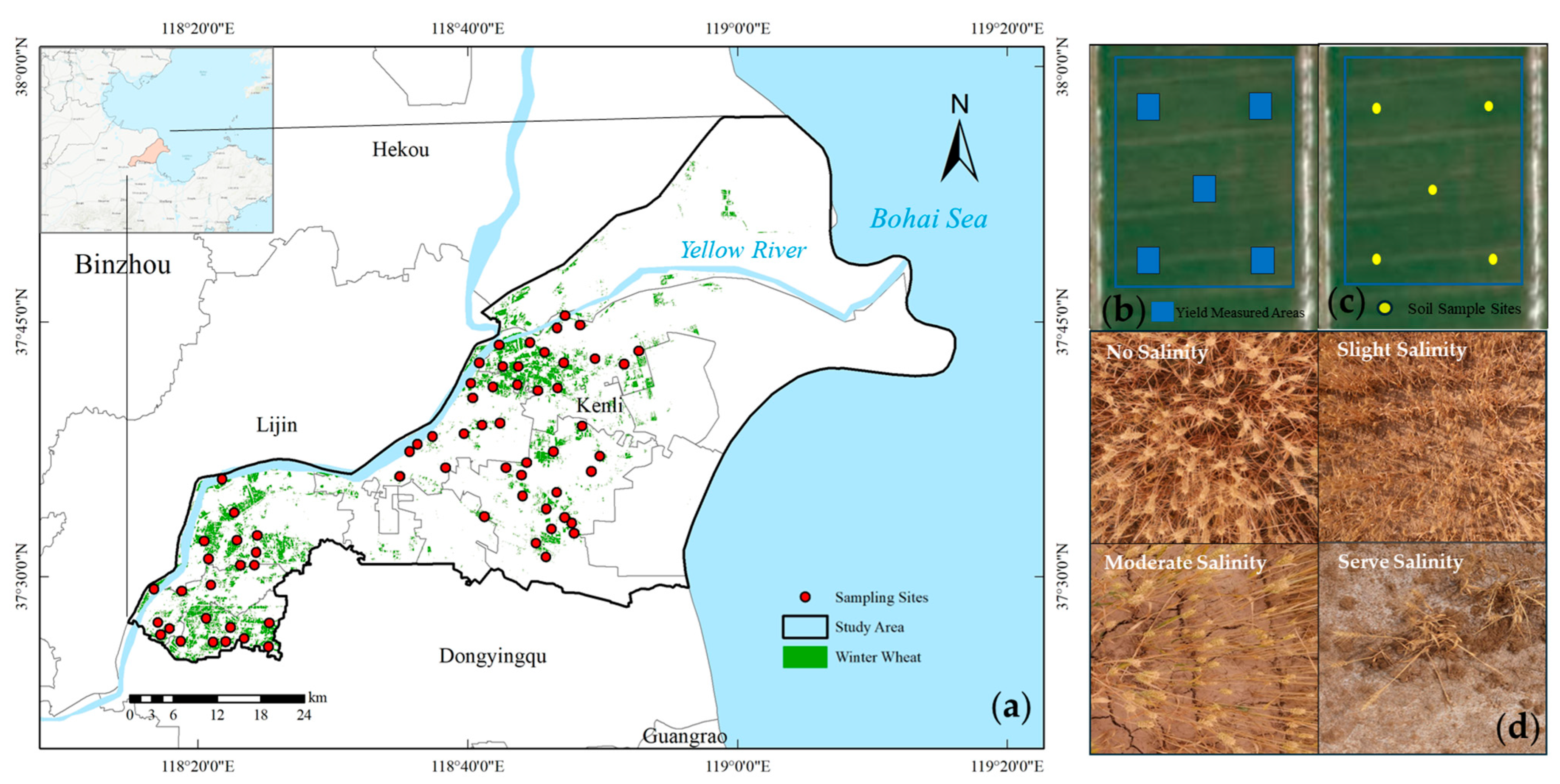


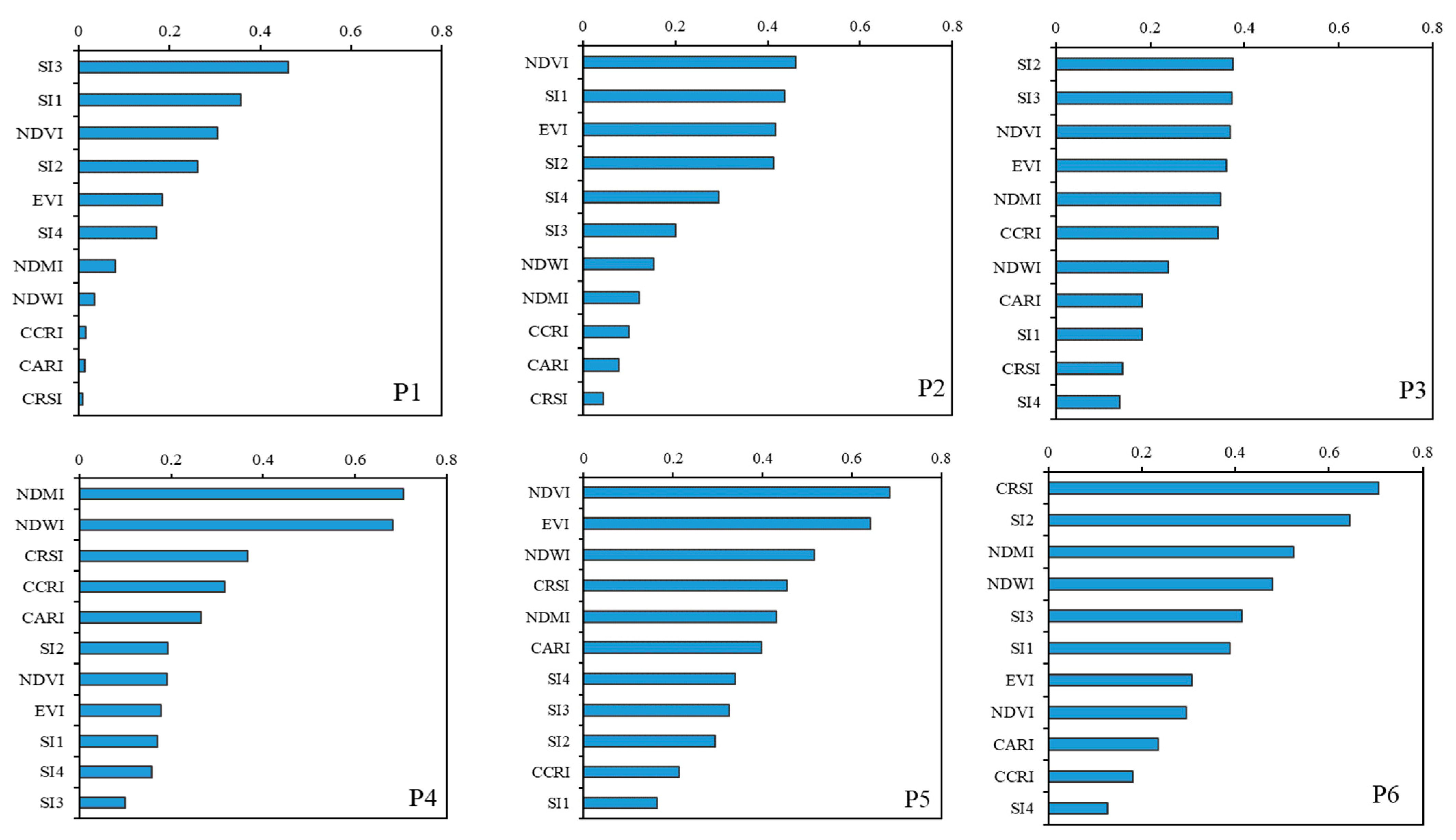

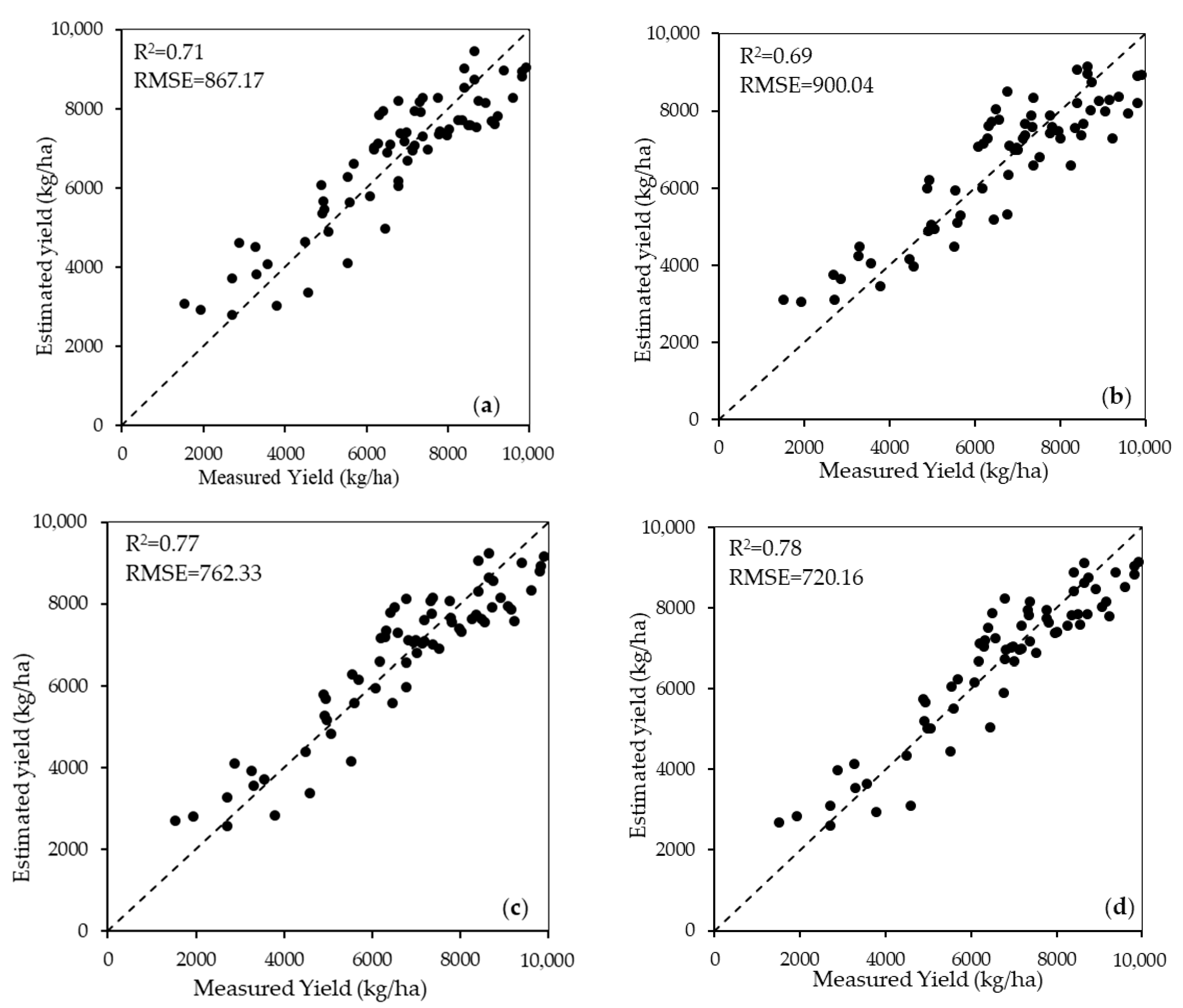
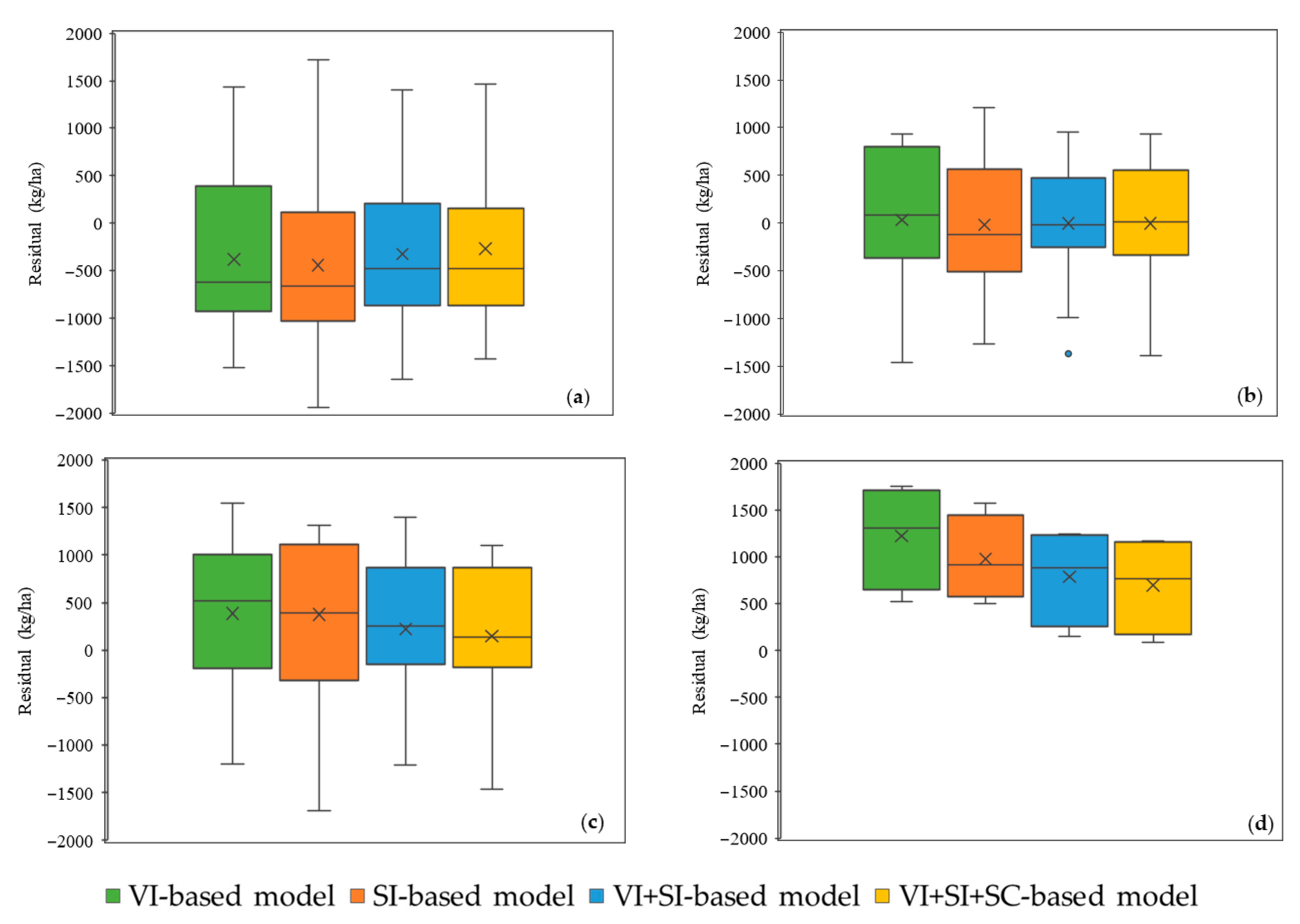
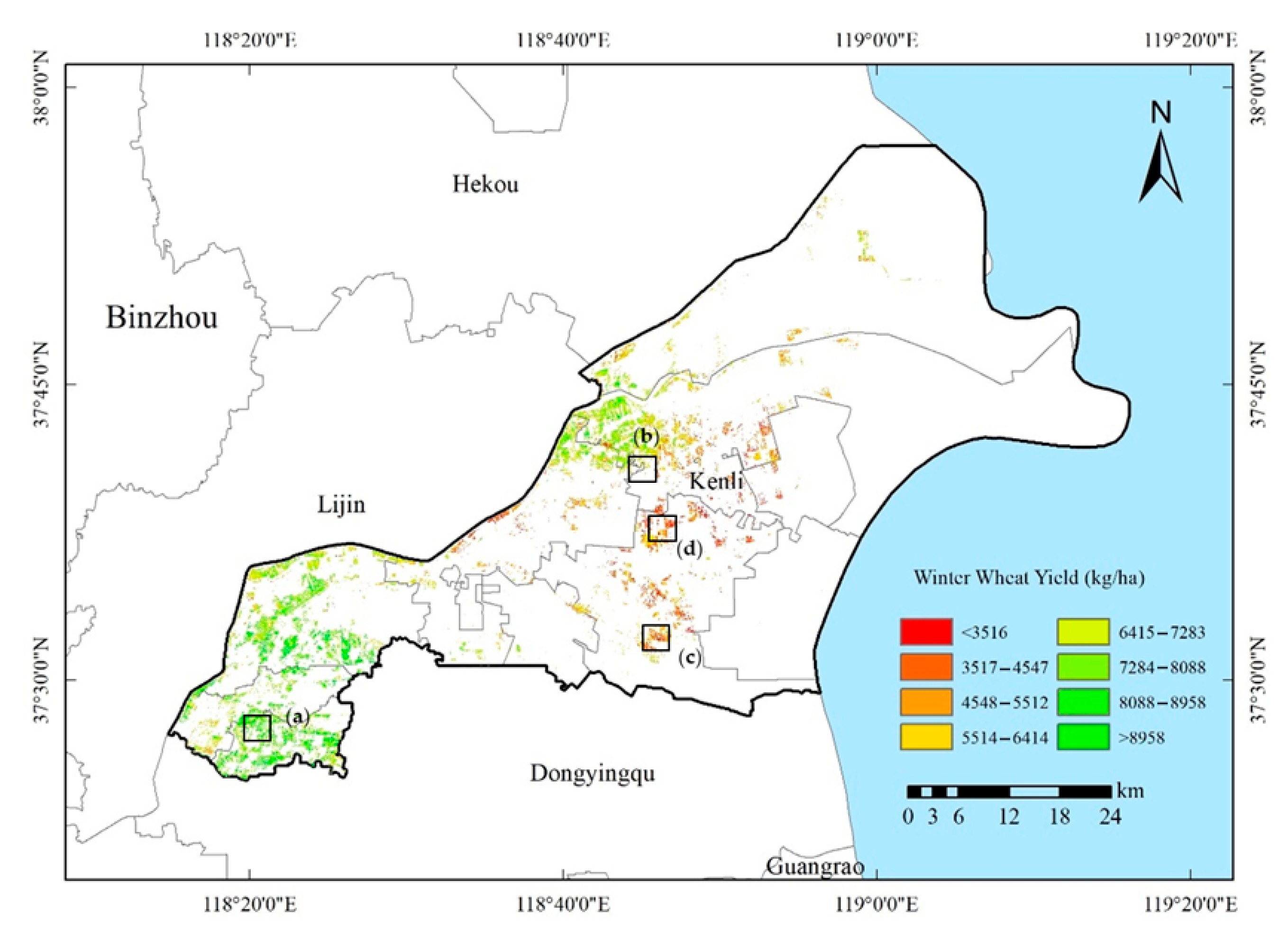
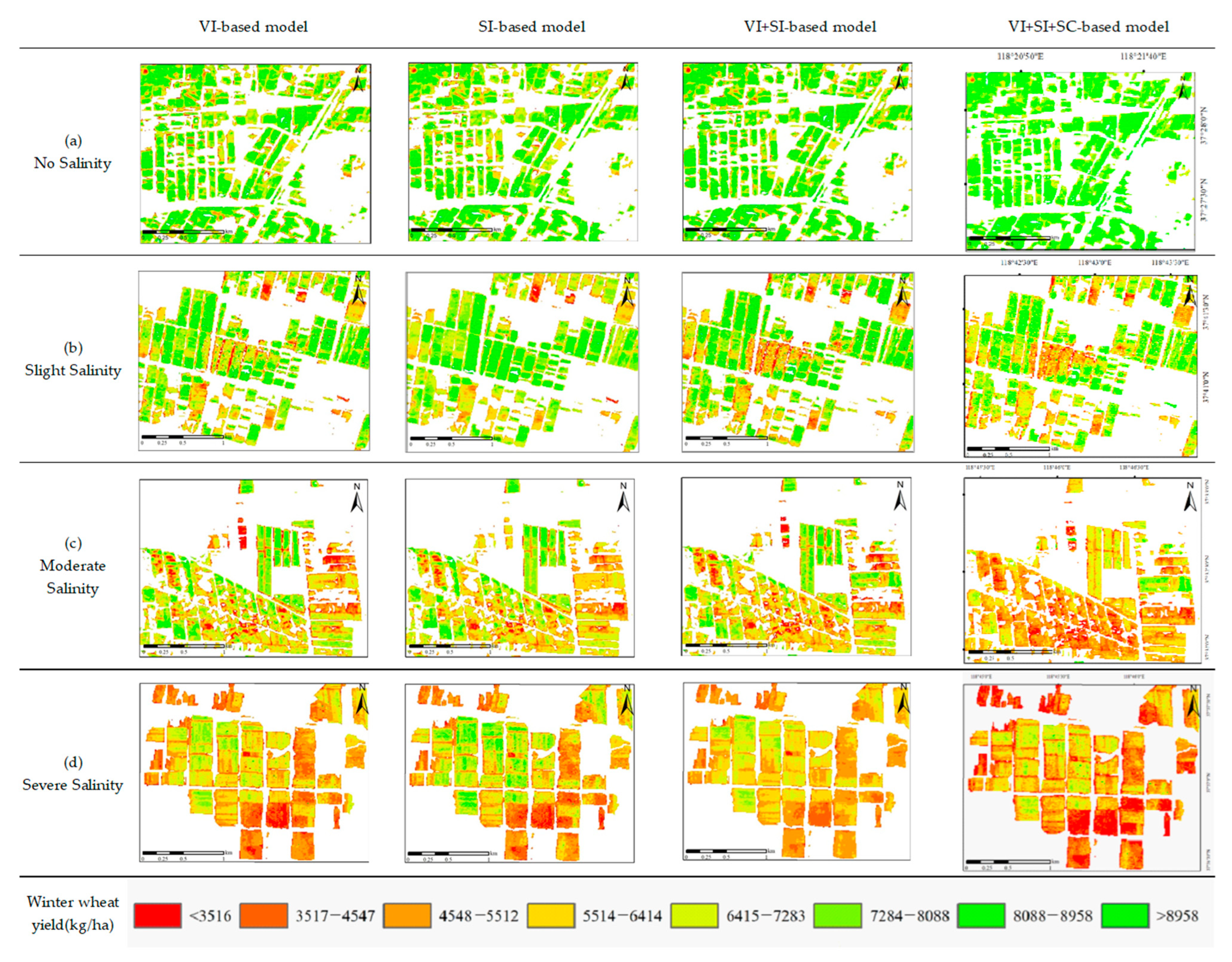
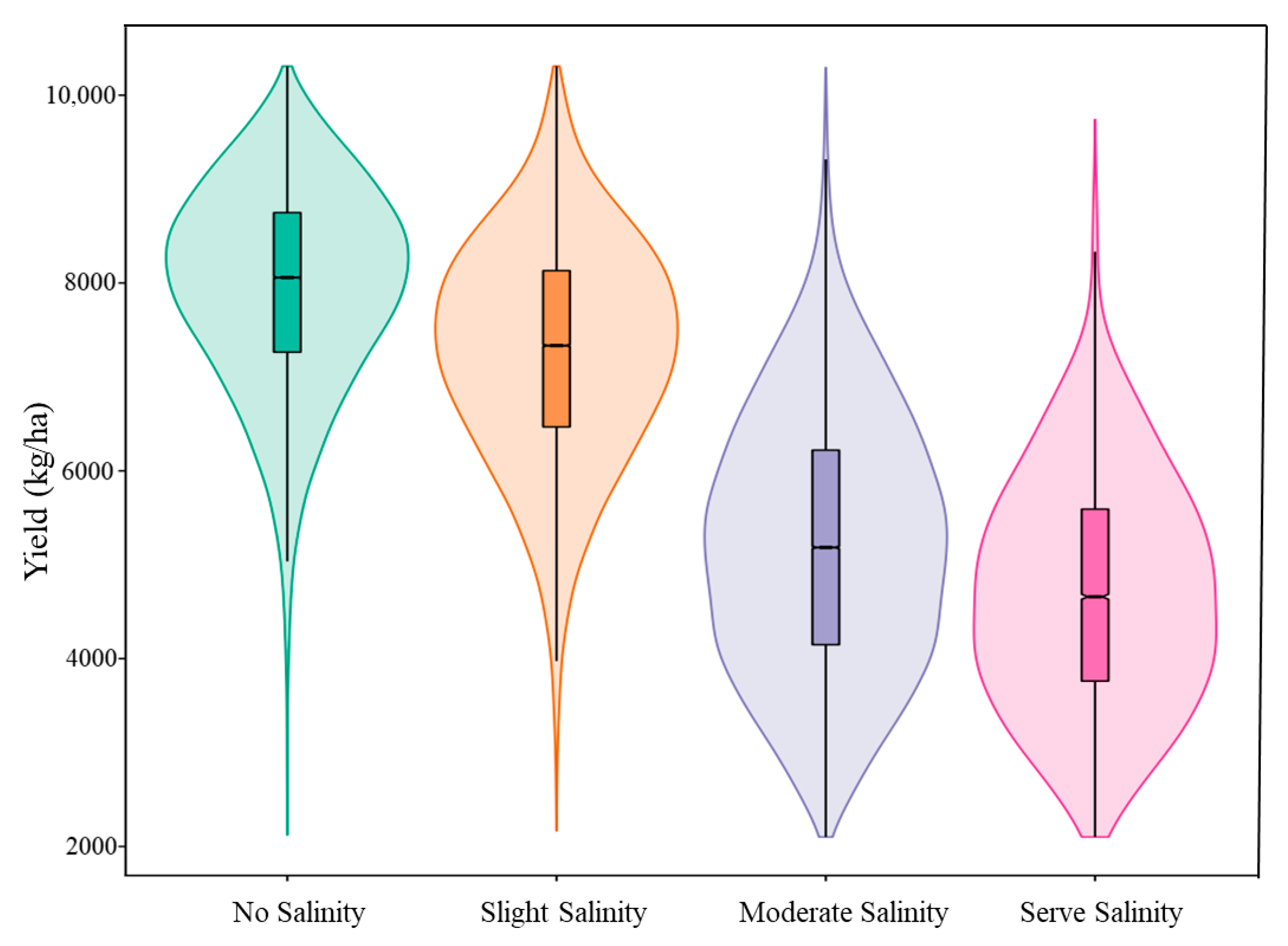
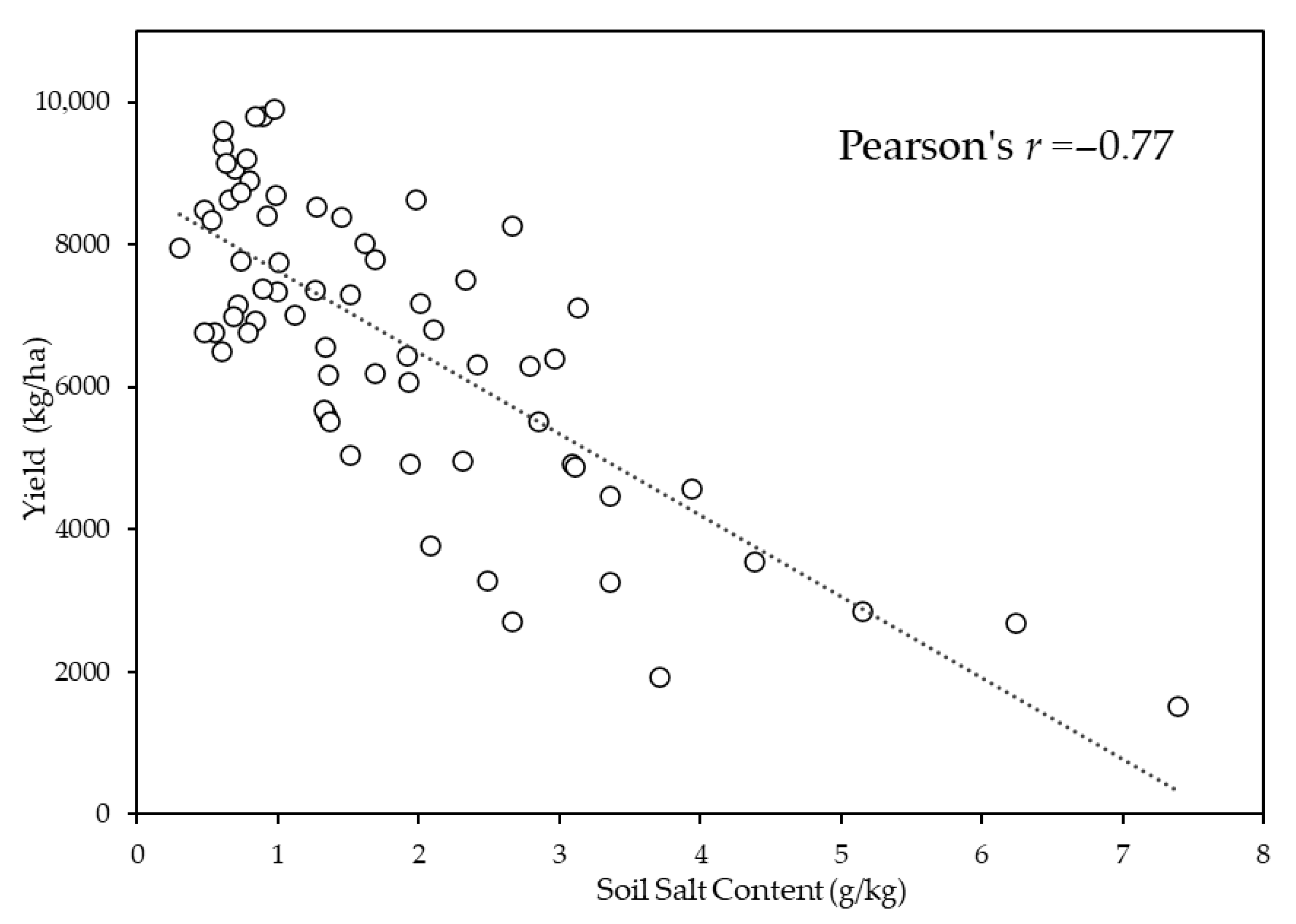
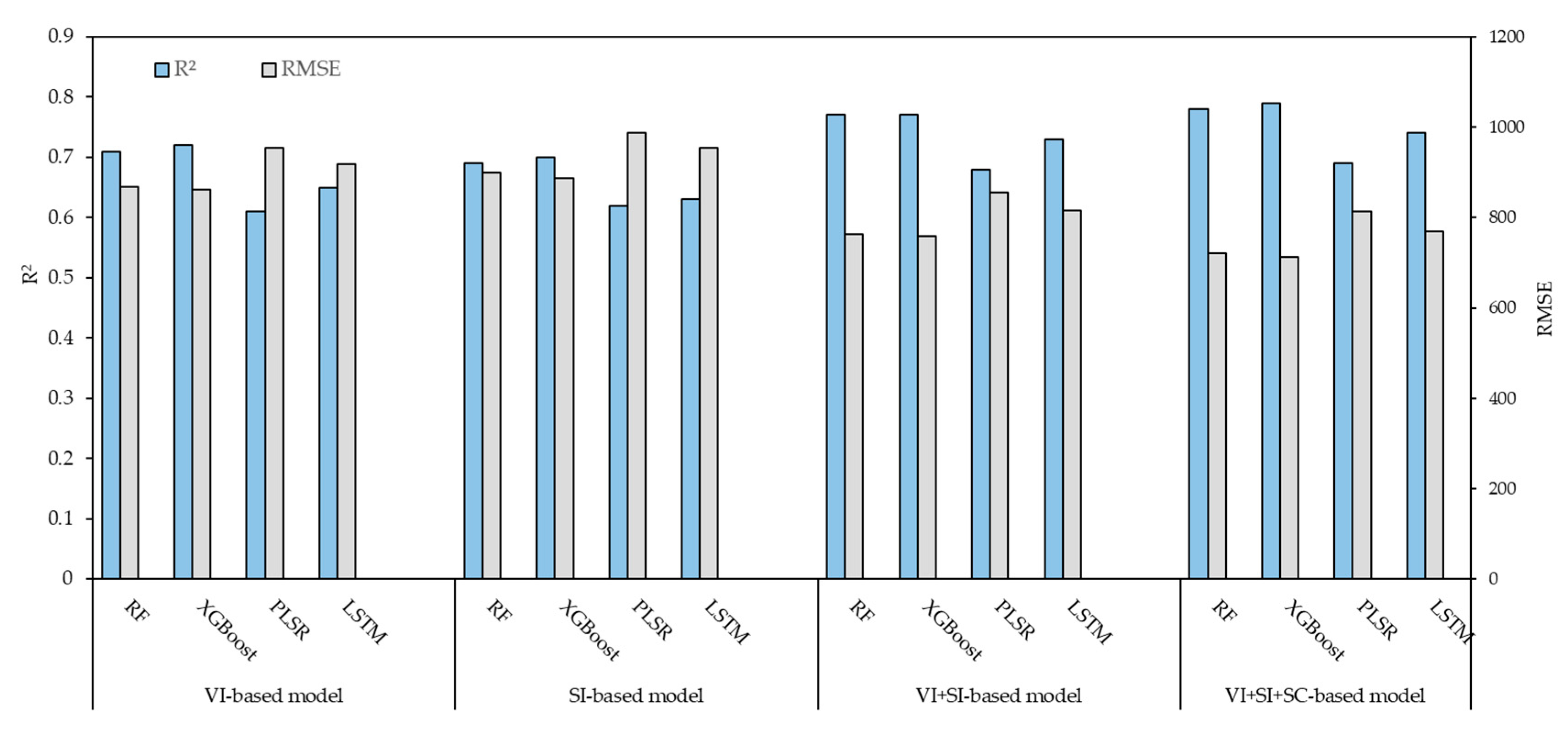

| Salinity Level | Samples | Soil Salt Content (SC) (g/kg) | Winter Wheat Yield (kg/ha) | ||||
|---|---|---|---|---|---|---|---|
| Min | Max | Mean | Min | Max | Mean | ||
| No | 26 | 0.30 | 0.99 | 0.72 | 6502.23 | 9904.48 | 8252.94 |
| Slight | 19 | 1.01 | 1.98 | 1.50 | 4918.38 | 8641.58 | 6795.65 |
| Moderate | 19 | 2.01 | 3.94 | 2.80 | 1928.61 | 8260.78 | 5368.14 |
| Severe | 4 | 4.38 | 7.39 | 5.79 | 1519.96 | 3559.61 | 2660.83 |
| Bands | Center Wavelength/nm | Resolution/m |
|---|---|---|
| Band 1—Coastal aerosol | 443 | 60 |
| Band 2—Blue | 490 | 10 |
| Band 3—Green | 560 | 10 |
| Band 4—Red | 665 | 10 |
| Band 5—Red-edge1 | 705 | 20 |
| Band 6—Red-edge2 | 740 | 20 |
| Band 7—Red-edge3 | 783 | 20 |
| Band 8—NIR | 842 | 10 |
| Band 8A—Narrow NIR | 865 | 20 |
| Band 9—Water Vapor | 945 | 60 |
| Band 10—SWIR Cirrus | 1380 | 60 |
| Band 11—SWIR1 | 1610 | 20 |
| Band 12—SWIR2 | 2190 | 20 |
| Growth Periods | Time | Images |
|---|---|---|
| P1 (seeding-tiller) | 15 October 2023–30 November 2023 | 25 |
| P2 (dormancy) | 9 December 2023–24 February 2024 | 31 |
| P3 (regreening) | 1 March 2024–31 March 2024 | 15 |
| P4 (jointing) | 5 April 2024–20 April 2024 | 8 |
| P5 (booting-flowering) | 26 April 2024–8 May 2024 | 5 |
| P6 (filling) | 12 May 2024–31 May 2024 | 12 |
| Parameters | Formula | References | |
|---|---|---|---|
| Vegetation Index (VI) | NDVI | [6] | |
| EVI | [4] | ||
| CARI | (B5 − B4) − 0.2 × (B5 − B3) | [24] | |
| CCRI | B8/B5 − 1 | [25] | |
| NDMI | [26] | ||
| NDWI | [27] | ||
| Salinity Index (SI) | SI1 | [15] | |
| SI2 | [28] | ||
| SI3 | B11/B8 | [28] | |
| SI4 | [29] | ||
| CRSI | [29] | ||
| Model Variant | Predictors | mtry | ntree | Nodesize |
|---|---|---|---|---|
| VI-based model | 18 | 6 | 100 | 3 |
| SI-based model | 13 | 4 | 100 | 3 |
| VI + SI-based model | 31 | 10 | 100 | 3 |
| VI + SI + SC-based model | 32 | 10 | 100 | 3 |
| Growth Periods | Vegetation Index | Salinity Index |
|---|---|---|
| P1 | NDVI | SI1, SI2, SI3 |
| P2 | NDVI, EVI | SI1, SI3, SI4 |
| P3 | NDVI, EVI, NDMI, CCRI | SI2, SI3 |
| P4 | NDMI, NDWI, CCRI, CARI | CRSI |
| P5 | NDVI, EVI, NDMI, NDWI, CARI | CRSI |
| P6 | NDMI, NDWI | CRSI, SI2, SI3 |
Disclaimer/Publisher’s Note: The statements, opinions and data contained in all publications are solely those of the individual author(s) and contributor(s) and not of MDPI and/or the editor(s). MDPI and/or the editor(s) disclaim responsibility for any injury to people or property resulting from any ideas, methods, instructions or products referred to in the content. |
© 2025 by the authors. Licensee MDPI, Basel, Switzerland. This article is an open access article distributed under the terms and conditions of the Creative Commons Attribution (CC BY) license (https://creativecommons.org/licenses/by/4.0/).
Share and Cite
Lu, C.; Yang, M.; Dong, S.; Liu, Y.; Li, Y.; Pan, Y. Improving Winter Wheat Yield Estimation Under Saline Stress by Integrating Sentinel-2 and Soil Salt Content Using Random Forest. Agriculture 2025, 15, 1544. https://doi.org/10.3390/agriculture15141544
Lu C, Yang M, Dong S, Liu Y, Li Y, Pan Y. Improving Winter Wheat Yield Estimation Under Saline Stress by Integrating Sentinel-2 and Soil Salt Content Using Random Forest. Agriculture. 2025; 15(14):1544. https://doi.org/10.3390/agriculture15141544
Chicago/Turabian StyleLu, Chuang, Maowei Yang, Shiwei Dong, Yu Liu, Yinkun Li, and Yuchun Pan. 2025. "Improving Winter Wheat Yield Estimation Under Saline Stress by Integrating Sentinel-2 and Soil Salt Content Using Random Forest" Agriculture 15, no. 14: 1544. https://doi.org/10.3390/agriculture15141544
APA StyleLu, C., Yang, M., Dong, S., Liu, Y., Li, Y., & Pan, Y. (2025). Improving Winter Wheat Yield Estimation Under Saline Stress by Integrating Sentinel-2 and Soil Salt Content Using Random Forest. Agriculture, 15(14), 1544. https://doi.org/10.3390/agriculture15141544





